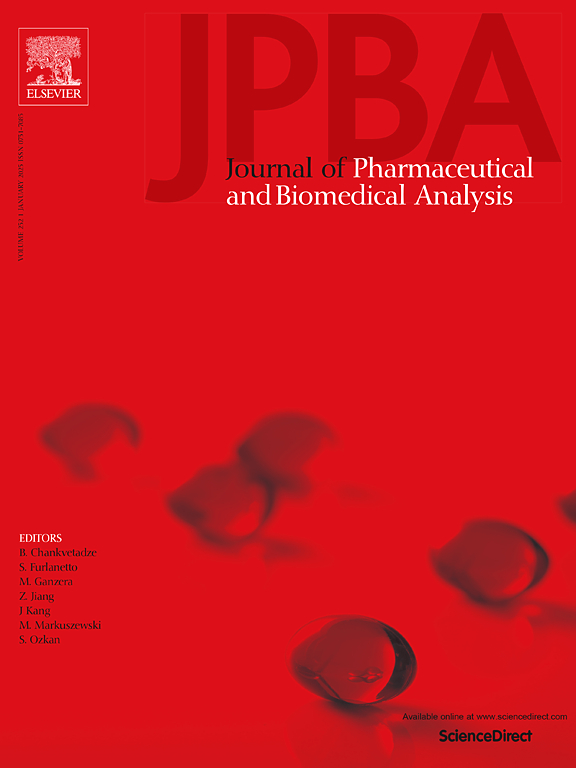Integrated metabolomics and gut microbiota analysis to explore the protective effects of Gushudan on postmenopausal osteoporosis rats via gut-bone axis
IF 3.1
3区 医学
Q2 CHEMISTRY, ANALYTICAL
Journal of pharmaceutical and biomedical analysis
Pub Date : 2025-05-03
DOI:10.1016/j.jpba.2025.116942
引用次数: 0
Abstract
Postmenopausal osteoporosis (PMOP) was caused by significant deviations in gut microbiota and metabolites. Gushudan (GSD), a small traditional Chinese medicine formula, exerted therapeutic effects including kidney-nourishing and bone-strengthening properties. The therapeutic mechanism of GSD in alleviating kidney-yang deficiency syndrome and secondary osteoporosis was systematically investigated through metabolomics and network pharmacology. However, the mechanisms and impact on gut microbiota through which GSD mitigated PMOP remained to be elucidated. In this study, fecal metabolomics was integrated with gut microbiota analysis to comprehensively investigate modification in intestinal flora and metabolic profiles in PMOP rat models from the gut-bone axis framework. Therefore, the GC-MS-based method integrating non-targeted and targeted metabolomics was established to analyze fecal metabolites. The comprehensive analysis of gut microbial communities was performed using 16S rRNA on fecal samples. In the result, 20 potential biomarkers were successfully identified in the non-targeted metabolomics analysis. Subsequently, 12 metabolites related to amino acid metabolism, energy metabolism and bile acid biosynthesis were quantitatively. Then, ten gut microorganisms with significant changes were discovered through 16S rRNA. Furthermore, alterations in fecal metabolites demonstrated a significant correlation with dysbiosis within the gut microorganisms such as [Ruminococcus]_torques_group, Elusimicrobium, Intestinimonas and Papillibacter. GSD effectively modulated abnormal levels of metabolites such as glycine, lactic acid, succinic acid, cholesterol and deoxycholic acid. Specifically, GSD improved the abundance of [Ruminococcus]_torques_group, Elusimicrobium, Intestinimonas. In conclusion, the gut-bone axis was validated as a novel framework, and gut microbiota modulation was further identified as a promising therapeutic target for the prevention of PMOP.
综合代谢组学和肠道菌群分析探讨骨疏丹对绝经后骨质疏松大鼠的肠-骨轴保护作用
绝经后骨质疏松症(PMOP)是由肠道菌群和代谢物的显著偏差引起的。骨疏丹(GSD)是一种小型中药配方,具有滋肾强骨等治疗作用。通过代谢组学、网络药理学等方法,系统探讨GSD对肾阳虚证及继发性骨质疏松症的治疗机制。然而,GSD减轻ppu的机制及其对肠道微生物群的影响仍有待阐明。本研究将粪便代谢组学与肠道菌群分析相结合,从肠-骨轴框架全面研究PMOP大鼠模型肠道菌群和代谢谱的改变。因此,我们建立了基于gc - ms的非靶向代谢组学和靶向代谢组学相结合的粪便代谢物分析方法。利用粪便样本的16S rRNA对肠道微生物群落进行综合分析。结果,在非靶向代谢组学分析中成功鉴定了20个潜在的生物标志物。随后定量分析了与氨基酸代谢、能量代谢和胆汁酸生物合成相关的12种代谢物。然后,通过16S rRNA发现了10个变化显著的肠道微生物。此外,粪便代谢物的改变与肠道微生物如[Ruminococcus]_torques_group, Elusimicrobium, intestine imonas和Papillibacter的生态失调有显著相关性。GSD能有效调节代谢产物如甘氨酸、乳酸、琥珀酸、胆固醇和去氧胆酸的异常水平。其中,GSD提高了[Ruminococcus]_torques_group, elusimicroum, testinimonas的丰度。综上所述,肠-骨轴被证实是一个新的框架,肠道菌群调节被进一步确定为预防ppu的有希望的治疗靶点。
本文章由计算机程序翻译,如有差异,请以英文原文为准。
求助全文
约1分钟内获得全文
求助全文
来源期刊
CiteScore
6.70
自引率
5.90%
发文量
588
审稿时长
37 days
期刊介绍:
This journal is an international medium directed towards the needs of academic, clinical, government and industrial analysis by publishing original research reports and critical reviews on pharmaceutical and biomedical analysis. It covers the interdisciplinary aspects of analysis in the pharmaceutical, biomedical and clinical sciences, including developments in analytical methodology, instrumentation, computation and interpretation. Submissions on novel applications focusing on drug purity and stability studies, pharmacokinetics, therapeutic monitoring, metabolic profiling; drug-related aspects of analytical biochemistry and forensic toxicology; quality assurance in the pharmaceutical industry are also welcome.
Studies from areas of well established and poorly selective methods, such as UV-VIS spectrophotometry (including derivative and multi-wavelength measurements), basic electroanalytical (potentiometric, polarographic and voltammetric) methods, fluorimetry, flow-injection analysis, etc. are accepted for publication in exceptional cases only, if a unique and substantial advantage over presently known systems is demonstrated. The same applies to the assay of simple drug formulations by any kind of methods and the determination of drugs in biological samples based merely on spiked samples. Drug purity/stability studies should contain information on the structure elucidation of the impurities/degradants.

 求助内容:
求助内容: 应助结果提醒方式:
应助结果提醒方式:


